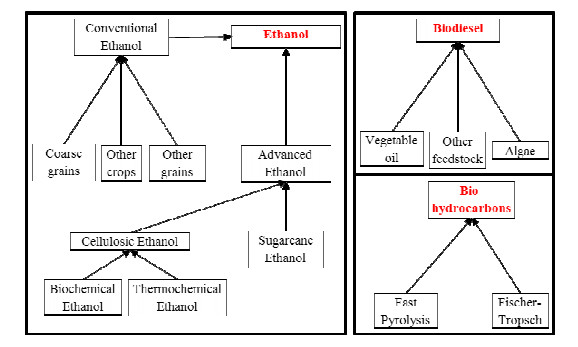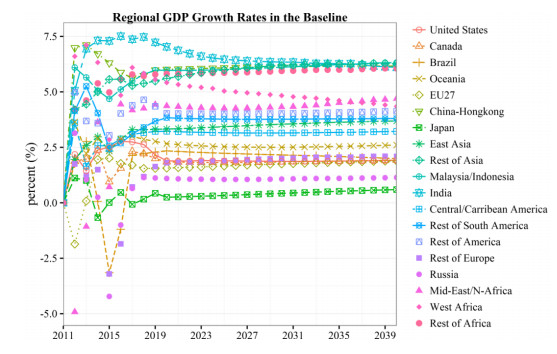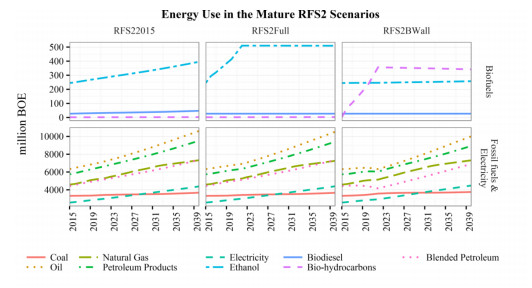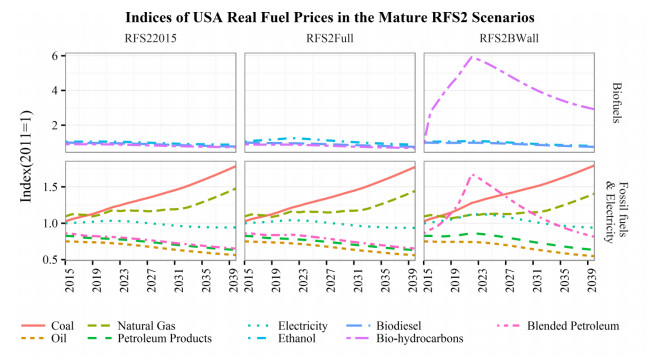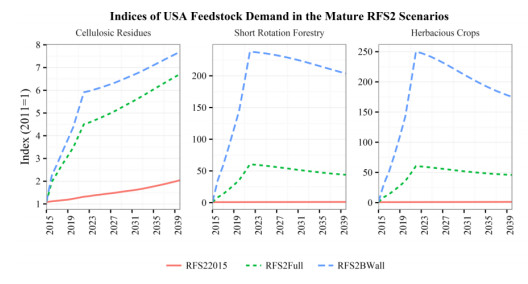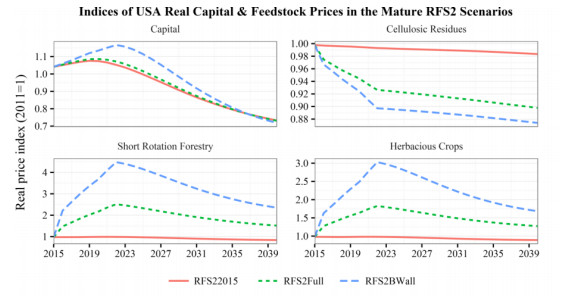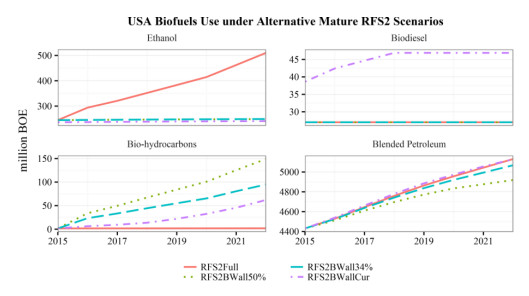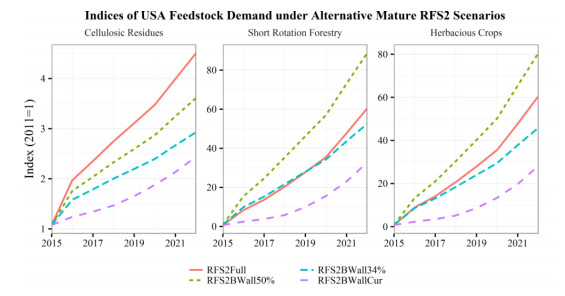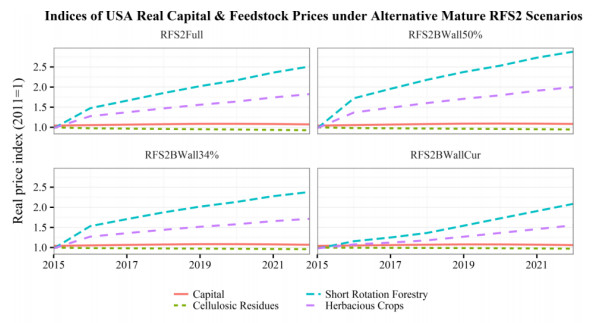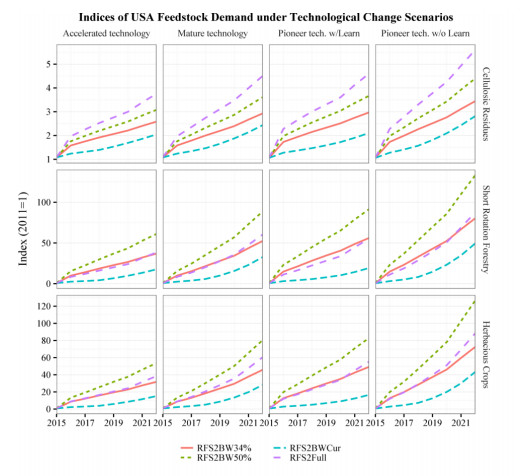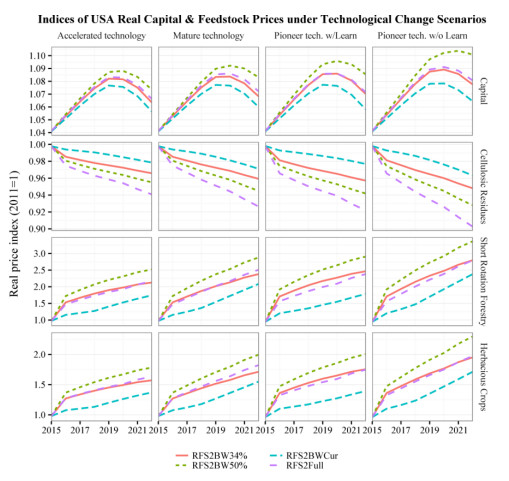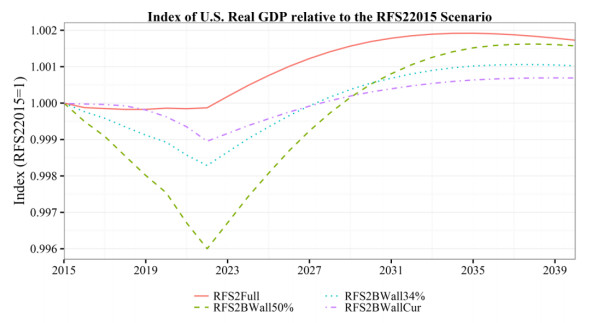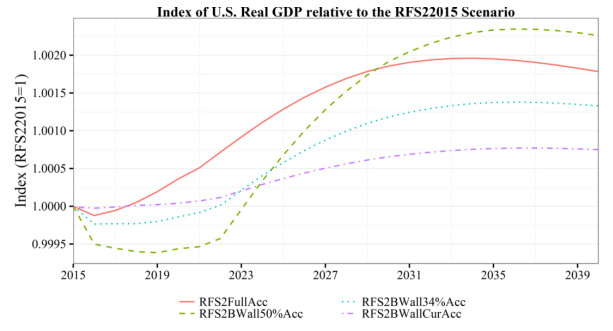1 This manuscript has been authored by UT-Battelle, LLC under Contract No. DE-AC05- 00OR22725 with the U.S. Department of Energy. The United States Government retains and the publisher, by accepting the article for publication, acknowledges that the United States Government retains a non-exclusive, paid-up, irrevocable, world-wide license to publish or reproduce the published form of this manuscript, or allow others to do so, for United States Government purposes. The Department of Energy will provide public access to these results of federally sponsored research in accordance with the DOE Public Access Plan (http://energy.gov/downloads/doe-public-accessplan).
1. Introduction
The renewable fuel standards (RFS) in the United States (USA) have led to an almost ten-fold increase in biofuel production from about 1.7 billion gallons in 2001 to almost 14 billion gallons in 2015. In particular, the RFS2, enacted under the Energy Independence and Security Act (EISA) of 2007, set a total target to incorporate 36 billion gallons of conventional and advanced biofuels in liquid transportation fuels by 2022 2. Conventional biofuels are to be produced from starchy feedstock with a maximum production target of 15 billion gallons by 2015. Advanced biofuels would contribute the remaining 21 billion gallons or 60 percent of the total RFS2 biofuel targets, and are expected to be produced from non-starchy feedstock. Most of the biofuels produced in the USA to date are conventional biofuels in the form of corn ethanol. Although the RFS2 requirements for advanced biofuels through 2015 are small relative to conventional biofuels, the annual targets for the former, except for biodiesel, have not been met so far [1].
2 The RFS2 is so-called because this 2007 legislation was an update on a 2005 renewable fuel standard (now known as RFS1) with a requirement of 7.5 billion gallons of biofuels by 2012.
Advanced biofuels hold the greatest potential for meeting the environmental objectives of the RFS2 legislation. It has been estimated that up to a billion tons of cellulosic materials can be produced in the USA for biofuel and other uses [2,3]. Advanced biofuels are required to lower GHG emissions by up to 60% relative to the equivalent volume of gasoline or three times as much as for conventional biofuels, representing the type of deep cuts needed to address the global warming impacts of liquid transportation fuels [4].
Differences in the deployment of conventional and advanced biofuels can be traced to two main factors. Corn-based ethanol in the USA is produced with mature technologies that have been developed and deployed over several decades using a readily available feedstock. Although the feedstock needed to produce advanced biofuels is available in the USA, most of the conversion technologies are still in the research and development (R & D) stages, and the logistics of feedstock supply for advanced biofuels production are not as well-developed as for conventional biofuels. Thus, production costs, which provide a snapshot of the state of market readiness, are higher for most advanced biofuel technologies relative to conventional technologies. Production costs are also highly uncertain in the infancy stage of a technology, as is the case for advanced biofuels, due to the large number of competing technologies with rapidly changing physical and economic performance characteristics. As such, in addition to their higher average costs, higher uncertainties associated with advanced biofuel technologies raise their competitiveness hurdle relative to competing fuels. The costs of new technologies change over time as R & D efforts and producer/consumer experience help to understand the opportunities for improved efficiencies and synergies with existing technologies, infrastructure and market conditions. This learning process is codified in the notion of "technological learning" [5]. Learning curves specify the unit change in the cost of production as a function of the cumulative production or installed capacity for a given technology. Costs to implement the first few units of a new technology are known as "pioneer" costs, whereas the costs of a long-standing technology that has been optimized over time based on extensive research, development and deployment are known as "mature" costs.
Although far from mature, advanced ethanol technologies are becoming increasingly competitive with conventional ethanol technologies [6]. Therefore the most daunting barrier to the increasing use of ethanol that would be produced from advanced biofuel technologies appears to be the blend wall. The blend wall refers to limits on the proportion of ethanol (about 10%) that can be mixed with gasoline without significant vehicle compatibility and efficiency penalties, and changes to the fuel supply infrastructure. The costs of these impacts to the extensive US fuel system and vehicle fleet may be large. The USA Environmental Protection Agency (EPA) has approved gasoline with up to 15 percent ethanol (E15) for use in vehicle model years 2001 and up. However, the deployment of E15 fuel has been slow because of required changes to pump infrastructure, and motorist fears over mis-fueling. A potential solution to the blend wall constraint is the development of drop-in biofuels or bio-hydrocarbons 3, which can directly replace fossil fuels or can be flexibly mixed with fossil fuels in existing and new vehicles [7]. Another potential option is to deploy vehicles designed to use larger proportions of ethanol without the penalties associated with ethanol use in existing flexible-fuel gasoline-ethanol vehicles [8]. However, the technologies to support these two options are less-developed than those for advanced ethanol production, and face the same logistical issues as any other advanced biofuel alternative.
3 Renewable hydrocarbon biofuels (also called “green” hydrocarbons, bio-hydrocarbons, drop-in biofuels, and sustainable or advanced hydrocarbon biofuels) are fuels produced from biomass sources through a variety of biological and thermochemical processes. These products are similar to petroleum gasoline, diesel, or jet fuel in chemical makeup and are therefore considered infrastructure-compatible fuels (http://www.afdc.energy.gov/fuels/emerging_hydrocarbon.html).
Given the short time frame for the deployment of advanced biofuel technologies under the RFS2 policy, there is a need to better understand the relative costs/benefits of alternative advanced biofuel deployment options. In addition, there is a need to understand the potential role of technological change in resolving current constraints to advanced biofuel deployment and to guide R & D efforts. This paper simulates the impacts of different policy scenarios on future growth of the USA biofuel market, and the role of factors highlighted above. The default scenario assumes that conventional biofuel requirements under the RFS2 are fully met up to 2015, and that incremental biofuel deployments beyond 2015 are largely driven by market conditions. Policy scenarios in which the RFS2 targets are imposed after 2015 are then examined under combinations of the blend wall constraint, biofuel technology costs and technological learning. The simulations are performed using EPGEM (Energy Policy in General Equilibrium Model), which enables the competitiveness of biofuel technologies to be determined in the context of fossil fuels and other energy markets, as well as the domestic/global economy.
The rest of the paper is arranged as follows. Section 2 provides an overview of EPGEM and describes the calibration of the model to its base year (2011) data. Section 3 discusses the simulated scenarios and their results, including implications of biofuel policy for USA energy use and prices, biofuel costs and inputs demand, and the overall economy. The paper ends with a conclusions section.
2. Material and methods
2.1. Overview of the energy policy in general equilibrium model (EPGEM)
EPGEM is an updated version of a global dynamic CGE (computable general equilibrium) model that has been used to simulate the economic and other impacts of USA biofuel policy [9,10,11]. EPGEM is based on version 9 of the GTAP database for 2011 4. The discussion in this section provides an overview of the model structure. EPGEM includes 19 regions of the world and 41 sectors of the economy (see the supplementary material for a list of regions and sectors). On the supply side, regional production by sectors of the economy is modeled with nested constant elasticity of substitution (CES) cost functions that combine primary factor inputs, including labor, capital, land and natural resources, with intermediate inputs. The nesting structure for production inputs in EPGEM is shown in Figure 1. The top nest consists of four sub-nests (grains/oilseed/animal feed, other agricultural materials, other materials, value-added/energy), along with individual services and other commodities (natural resources, trade services, transportation services, construction & housing, and public health & defense). The grain/oilseeds/animal feed sub-nest is designed to reflect the substitution possibilities across these three commodities in the livestock sectors. Other agricultural products are included in a separate sub-nest, and the remaining material inputs are in another sub-nest. The value-added/energy sub-nest consists of skilled and unskilled labor inputs, and two sub-nests for land, and capital/energy. The land sub-nest represents the demand for land in 18 agro-ecological zones (AEZ) of each region in the model. Agro-ecological zones are designed to capture agricultural productivity differences across a region's landscape based on climate regimes and length of growing periods. The capital/energy sub-nest consists of capital and composite energy inputs, and the latter is further sub-nested to reflect substitution possibilities among different types of fuels. This version of the model includes a new petroleum products blending sector that combines between 70% and 80% of oil refining products with biofuels (ethanol, biodiesel and bio-hydrocarbons) to produce blended petroleum products. Thus, biofuels are substitutes for oil products and for each other to capture the objectives of biofuel policy, and the range of potential biofuel technologies and products. The ease of replacing bio-hydrocarbons with petroleum products is captured by using a larger elasticity of substitution in the corresponding sub-nest in Figure 1. Other production sectors of the economy do not purchase biofuels directly, but purchase a mix of the unblended and blended petroleum products. The production of biofuels in EPGEM is not based on the structure shown in Figure 1, but uses a separate technology based structure as discussed below.
4 GTAP is a global economic database/modeling framework was developed at the Center for Global Trade Analysis at Purdue University, USA. This database is widely used in global general equilibrium models and is available for a fee.
The expenditure side of EPGEM is based on the Constant Difference of Elasticities (CDE) function as in previous versions of the model, but the income-expenditure accounting has been improved. In previous versions of the model, and most GTAP-based models, all payments to the primary factors of production (i.e. labor, capital, land and other natural resources) as well as taxes are received by a regional household, and allocated to private households, government and savings. In EPGEM, a private household collects all incomes paid to the primary factors of production, net of taxes, and allocates the income between expenditures on goods/services and savings. Similarly, the government collects all taxes/tariffs paid in each region, and allocates the income between expenditures on commodities and savings using fixed shares. Total regional savings is the sum of private household and government savings which, combined with net savings by foreign economies, finance investments in a given region. Since net foreign savings in a given region could be positive or negative, regional investments could be greater or less than total domestic savings, implicitly capturing international borrowing/lending. Additional details on biofuel production and technology learning are provided below, and the supplementary material describes household vehicle/fuel choice behavior in EPGEM.
2.2. Technology-based modeling of biofuel production
Previous versions of EPGEM included each biofuel technology as a separate sector of the economy. In contrast there are only three separate biofuel sectors i.e. ethanol, biodiesel and bio-hydrocarbons (representing drop-in biofuels) in EPGEM. The output of each of these three sectors is then modeled as the combination of outputs from competing technologies. As shown in Figure 2 ethanol can be produced from three conventional and three advanced biofuel technologies, and biodiesel can be produced from three types of technologies. Bio-hydrocarbons are currently produced from fast pyrolysis and Fischer-Tropsch (FT) technologies in EPGEM, which are the two prominent options for which data were available.
The nesting structure in Figure 2 is implemented in EPGEM using a logit specification [12,13]. The logit model in a CGE model is closely related to the CES function used to model production activities in other sectors of the economy. However, the logit specification allows both quantity and cost/revenue components to add up to their totals, whereas the ordinary specification of the CES function only guarantees that cost/revenue components add up. Since a balanced account of quantities is crucial to the allocation of products among different technologies the logit model is used for this purpose. Table 1 contains estimates of the base year (2011) production costs for key biofuel technologies in the USA, which are interpreted as mature production costs. The cost profiles of inputs are from a combination of sources. For advanced biofuel technologies the cost profiles are based on techno-economic assessments in the USA [14,15,16,17,18]. Conventional biofuels production data and costs are based on Zhou and Kojima [19] and available 2011 data for regions in the model.
Table 1. Mature conversion costs for key USA biofuel technologies in EPGEM ($2011).
|
$/gal
|
$/gge
|
|
$/gal
|
$/gge
|
|
Starch-based ethanol
|
|
|
Biodiesel
|
|
|
| Coarse grains |
2.55 |
3.82 |
Vegetable oil |
3.75 |
4.24 |
| Other grains |
2.87 |
4.30 |
Other feedstock |
4.05 |
4.55 |
|
Cellulosic ethanol
|
|
|
Algae* |
4.10 |
4.61 |
| Thermochemical |
2.76 |
4.10 |
Bio-hydrocarbons
|
|
|
| Biochemical |
3.05 |
4.50 |
Fast pyrolysis |
4.00 |
4.00 |
|
|
|
Fischer-Tropsch |
4.2 |
4.2 |
| *This includes only the cost of converting algal oil to biodiesel. Estimates of the cost of algal oil production vary widely. |
Biofuel technologies in EPGEM produce multiple products. The importance of co-products/by-products to the economics and environmental implications of biofuels is well-recognized [20]. DDGS (distiller's dry grains), a co-product of corn ethanol production in the USA, is a source of animal protein that improved the profitability of ethanol producers and minimized the crop market impacts of corn ethanol production [21]. Similarly, non-food grade corn oil from the ethanol production process has become a significant feedstock for biodiesel production in the USA. In Brazil, the sugarcane ethanol industry produces a significant amount of electricity from bagasse, which is a by-product of sugarcane processing for ethanol or sugar production [22]. Co-products are also likely to be crucial to the economics and environmental aspects of the emerging advanced biofuel industry. In previous versions of the model, DDGS was modeled with a simple proportional relationship to the output of ethanol. The approach in EPGEM uses a non-diagonal MAKE-matrix that explicitly incorporates these co-products into the pricing and sales accounts of biofuel producers, and can be easily extended to other sectors of the economy.
2.3. Technological learning for biofuel conversion technologies
Technological change can be modeled in a CGE model through technical efficiency parameters of production, consumption and other functions used to specify economic behavior. These parameters are usually exogenous and held constant in simulations, but can include endogenous components using appropriate specifications. The aggregate technical efficiency parameter is used to specify exogenous changes in overall productivity/efficiency of production processes in CGE models, leading to proportional changes in unit production costs, all else constant. For the purpose of this study, endogenous components have been added to the aggregate technical efficiency parameter for advanced biofuel technologies (biochemical ethanol, thermochemical ethanol, fast pyrolysis and FT). These endogenous components are based on the technology learning function (or technology experience curve) which specifies the unit cost of production as a function of cumulative installed production/capacity and a learning parameter [5]. For the implementation in EPGEM the modified aggregate technical efficiency parameter is specified as:
aotchi, r = percent change in technical efficiency coefficient for biofuel technology i in region r; saotchi, r = exogenous percent change in technical efficiency coefficient for technology i in region r;
lpari, r = learning parameter for technology i in region r;
qi, r = percent change in cumulative output/capacity of technology i in region r.
The learning parameter (lpar) in Equation (1) can be interpreted as a cost elasticity with respect to cumulative output/capacity. It is related to the learning rate (LR), which is defined as the proportional cost change per doubling of cumulative production or capacity: 5
5 Note that the term (1-LR), the complement to LR in equation (2), is also known as the Progress Ratio (PR). Equation (2) is based on the learning rate equation: LR = 1–2-lpar.
Values of LR for thermochemical and biochemical ethanol technologies are calculated from preliminary estimates for pioneer integrated bio-refineries by Argo et al. [23] for three segments of the technology experience curve. The first segment represents early build-up of the technology, corresponding to an LR value of 0.15. The second and third segments represent progress towards maturity during which learning rates slow considerably to 0.075 and 0.015, respectively. These values are also applied to bio-hydrocarbon technologies in the model. In order to reflect the different segments of the learning curve, equation (2) is implemented in the model as:
Qt-1, i, r is the level of production for technology i in the previous period in region r, and Q0, i, r is its initial base year value at the beginning of the simulation (i.e. 2011 in this case). The above implementation of the technology experience curve implies that learning is both endogenous and non-linear in the model simulations. Technology "unlearning" is disallowed by setting the learning parameter and change in technical efficiency to zero if total production in a given year is lower than in the previous year.
2.4. Model calibration and baseline simulation
The model is calibrated based on forecasts of economic and population growth rates from the World Economic Outlook database [24]. Forecasts from the USA Energy Information Administration (EIA) International Energy Outlook 2013 [25] and Annual Energy Outlook 2015 [26] are used to reflect changes in the global energy market. The surge in oil and gas production in the United States is captured through exogenous increases in the production of these resources to approximate growth rates in the AEO2015 Reference forecast. Other data needs for specifying the model, including the GTAP database, supply curves for fossil energy resources and supply curves for cellulosic biofuel feedstock are compiled from the same sources as in previous versions of the model [11]. For calibration purposes, regional gross domestic product (GDP) growth rates are exogenous, and parameters representing the average regional productivity of primary factors of production (excluding capital) are endogenous to re-balance the model. For policy simulations the regional productivity parameters are fixed at the calibrated levels and the regional gross domestic products are endogenous. Figure 3 shows the regional GDP growth rates from 2004 to 2040 used in the calibration process, which are nearly constant after 2020.
3. Scenarios and Simulation Results
3.1. Description of biofuel policy simulation scenarios
The scenarios used to examine alternative future paths of the USA biofuel market under the RFS2 policy are highlighted below:
3.1.1. Primary mature technology scenarios
These scenarios assume that biofuel conversion technologies in the USA are available at mature production costs (see Table 1). Since biofuel supply costs and their components are endogenous in EPGEM, Table 1 represents the initial values of these costs in the base year (2011) of the model. Biofuel costs change during the simulations based on changes in input supply costs (e.g. feedstock supply curves) and demand. Three primary mature technology scenarios are examined:
(1) RFS22015: This scenario holds the mandated blending rate of biofuels into the liquid fuel mix constant at 2015 levels through 2022. Thus, changes in biofuel use in this scenario are largely driven by market processes after 2015.
(2) RFS2Full: This scenario assumes a full implementation of the RFS2 targets through 2022 without blend wall constraints, representing the easiest potential path for meeting the policy targets.
(3) RFS2BWall: This scenario assumes a full implementation of the RFS2 targets through 2022, but with blend wall constraints on ethanol. Under this scenario, the amount of ethanol and biodiesel blended into the US liquid fuel mix are held constant after 2015. Thus, mandated increases in biofuels blending after 2015 require bio-hydrocarbons, which are not constrained by the blend wall. In addition, households can still purchase ethanol for use in flexible-fuel and mid-blend gasoline-ethanol vehicles.
3.1.2. Alternative blend wall scenarios with mature technology
The blend wall constraint on ethanol and the infancy stage of drop-in biofuels has kept the deployment of advanced biofuels below the levels anticipated under the RFS2 policy. As a result, the EPA has exercised its statutory powers to modify the biofuel blending requirements based on estimates of potential supply. The following alternative scenarios are examined to provide insights into the potential impacts of changes to the original volumetric requirements under the RFS2 on the development and economic benefits of advanced biofuels in the USA:
(1) RFS2BWall50%: This scenario scales the post-2015 growth path for the deployment of biofuels under the RFS2 policy with the blend wall by a factor of 0.5 to compensate for the extra-cost per gallon of drop-in biofuels relative to cellulosic ethanol.
(2) RFS2BWall34%: This scenario further scales the growth path of advanced biofuels in the RFS2BWall50% scenario by a factor of 0.68 to reflect differences in the energy content of drop-in biofuels and ethanol. Thus, the volume of bio-hydrocarbons deployed in this scenario approximates the energy content of deploying the RFS2BWall50% volume as ethanol.
(3) RFS2BWallCur: This scenario attempts to match the potential deployment path for advanced biofuels based on recent modifications to the statutory requirements. Given the 2016 and 2017 values in the recent EPA announcements, the annual growth rate of cellulosic and other advanced biofuels (not including biodiesel) between 2016 and 2022 are assumed to be 36% and 14% respectively [27]. In addition, the deployment of biodiesel after 2011 is adjusted to reflect actual growth rates, and assumed to reach about 2.1 billion gallons by 2018 as specified in the announcements.
3.1.3. Alternative technology scenarios
These scenarios examine the implications of technology maturity on input demand and costs, and the overall economic impacts of biofuel deployment under four of the above scenarios (RFS2Full, RFS2BWall50%, RFS2BWall34% and RFS2BWallCurr). Two sets of alternative technology change scenarios are simulated as follows:
(1) Pioneer technology (with/without learning) scenarios: These scenarios are simulated with pioneer conversion technology costs, which is implemented in EPGEM by reducing the technical efficiency of advanced biofuel conversion technologies by 30% in 2012 (this is the first year of policy simulations, given that the base year of the model is 2011). The without learning simulations are identified by the suffix "PioNL" and with learning simulations are identified by the suffix "PioL" in the discussion below.
(2) Accelerated technology scenarios: These simulations are optimistic scenarios in which the estimated mature production costs in Table 1 are combined with technology learning. These scenarios are designed to represent a breakthrough case where current difficulties with bio-hydrocarbons technologies are quickly solved. These simulations are identified by the "Acc" suffix in the discussion below.
Note that because the "other advanced biofuels" category in the RFS2 is not captured in EPGEM, all advanced biofuels are ethanol, bio-hydrocarbons or biodiesel in these simulations.
3.2. Fuel demand and cost in the USA: mature technologies results
Figure 4 shows the energy use results for the USA under the three primary mature technology scenarios. Values have been converted to million barrels of oil equivalent (mmBOE) by applying growth rates from the simulation results to physical values for 2011 6. Blended petroleum products consumption in 2022, which includes biofuels, remains nearly the same under the RFS2Full scenario (without the blend wall) relative to the RFS22015 scenario, whereas the RFS2BWall scenario (with the blend wall) leads to a reduction of almost 20%. In the RFS22015 scenario, ethanol use increased by about 20% in 2022 and by almost 60% in 2040 relative to 2015, whereas biodiesel use increased by almost 50% in 2022 and more than doubled in 2040. In the RFS2Full scenario the biofuel mandates are met by 2022 according to the volumetric requirements under the RFS2 policy and remain nearly constant after that year by design. Cellulosic ethanol is used to meet almost all the volumetric requirements for advanced biofuels, with the near zero growth of bio-hydrocarbons reflecting its higher competitiveness hurdle relative to other biofuels. However, the blend wall constraint on ethanol forces a large increase in bio-hydrocarbons after 2015 under the RFS2BWall scenario, reaching more than 350 mmBOE by 2022.
6 Note that there are 5.8 million BTU per barrel of oil, 3.563 million BTU per barrel of ethanol, 5.359 million BTU per barrel of biodiesel and 5.215 million BTU per barrel of gasoline. Bio-hydrocarbons have been converted using the value for gasoline (see https://www.eia.gov/outlooks/aeo/pdf/appg.pdf).
The displacement effect of biofuels is indicated by differences in the use of oil and petroleum products (without biofuels) across the three scenarios. Under the RFS22015 scenario, oil and petroleum use track each other closely. The annual demand for petroleum products in the USA fell by about 250 mmBOE in 2022 under the RFS2Full scenario, relative to the RFS22015 scenario. The decline in petroleum products use under the RFS2BWall scenario is more than 750 mmBOE, which is about twice the volume of bio-hydrocarbons added to the fuel mix. These results imply that consumers did not respond to the blend wall constraint by increasing the number of mid-or flexible-blend gasoline-ethanol vehicles. Instead, the extra costs of bio-hydrocarbons, as discussed below, lead to reductions in fuel purchases. This makes sense since changes in the vehicle stock are much slower than the biofuel deployment rates implied by the RFS2, causing these costs to be reflected in fuel purchases rather than a shift to more efficient or ethanol compatible vehicles.
Figure 5 shows that the real price indices for biofuels are generally below unity throughout the horizon, except for bio-hydrocarbons under the RFS2BWall scenario. In the latter scenario, costs jumped in 2016 and the real production cost index reached about 6 by 2022. Thus, even with mature conversion technology costs, these results suggest that a rapid increase in the production of bio-hydrocarbons to circumvent the blend wall and meet the volumetric targets of the RFS2 would be costly. Real price indices for coal and natural gas in Figure 5 rose to about 1.2 by 2022 under the RFS22015 scenario, whereas those for oil and petroleum-products decline to about 0.8. The pattern of real fossil fuel prices is similar for the RFS2BWall scenario, except for blended petroleum products which nearly doubled by 2022 due to the cost of bio-hydrocarbons.
3.3. Input demand and costs for biofuel production: mature technology results
Figure 6 shows the indices of cellulosic feedstock demand by type. Under the RFS2Full scenario, indices for residues and dedicated energy crops demand increase to about 5 and 60 in 2022, respectively. The physical values of residue demand in the USA in EPGEM for 2015 is about 30 million tons and about 0.8 million tons for each of the dedicated energy crop types, which are used only for bio-power and advanced biofuels in the model. These results imply that about 240 million tons of cellulosic feedstock would be required under the RFS2Full scenario by 2022. The demand for cellulosic feedstock in the RFS2BWall scenario is almost three times that for the RFS2Full scenario.
Figure 7 shows that real price indices for dedicated energy crops under the RFS2BWall scenario (3 to 5 in 2022) are about double those for the RFS2Full scenario (1.75 to 2.5 in 2022). These results match the much higher demand for cellulosic feedstock under the RFS2BWall scenario, and in particular suggest that this scenario accesses the steepest parts of feedstock supply curves. The real price index for capital inputs rise slightly before declining after 2020, but is larger under the RFS2BWall scenario than for the RFS2Full scenario by up to 10%. This reflects the higher demand for investment, and premium on returns, to support bio-hydrocarbon production relative to cellulosic ethanol. In contrast, the cost index for residues under the RFS2BWall scenario is lower than for the RFS2Full scenario. This seemingly counterintuitive result is primarily due to downward shifts of cellulosic residues supply curves in real cost terms over time, which in turn is due to increases in the yields of agricultural crops (see the supplementary material for examples of cellulosic supply curves).
3.4. Simulation results for alternative blend wall scenarios: mature technology results
Figure 8 shows the deployment of biofuels under the three alternative blend wall scenarios, as well as the RFS2Full scenario. Since the path of ethanol is constrained, its deployment in all blend wall scenarios is about 15 billion gallons. The maximum deployment of bio-hydrocarbons under the alternative blend wall scenarios is about half of the RFS2 advanced biofuel targets for 2022. The RFS2BWallCur scenario has the lowest deployment of bio-hydrocarbons at only 50 mmBOE (or about 2 billion gallons) by 2022. However, the deployment of biodiesel also increases to about 2 billion gallons by 2018 in the RFS2BWallCur scenario, whereas it is constrained to about 1 billion gallons under the RFS2BWall50% and RFS2BWall34% scenarios in Figure 8. Recall that the RFS2BWallCur scenario reflects actual biofuel deployment rates between 2011 and 2015, and rates after 2015 implied by recent regulatory announcements. The path of blended petroleum use for the RFS2BWallCur scenario almost coincides with that of the RFS2Full scenario and also, but slightly less so, with that of the RFS2BWall34% scenario. In addition, the decline in blended petroleum use under the RFS2BWall50% in 2022 is only about 4%, which is much lower than the 20% decline under the RFS2BWall scenario in Figure 4.
The cellulosic input use results in Figure 9 are direct reflections of biofuel deployment levels under the alternative blend wall scenarios. The RFS2Full scenario requires more residues than all the three alternative blend wall scenarios, but its dedicated energy crop uses are close to those for the RFS2BWall34% scenario. Given the greater deployment of biodiesel under the RFS2BWallCur scenario, it requires much lower residues and dedicated energy crops than the RFS2Full scenario. Figure 10 shows that real feedstock price indices for the RFS2Full and RFS2BWall34% scenarios are nearly identical, while those for the RFS2BWall50% are higher and those for the RFS2BWallCur are slightly smaller than for the RFS2Full scenario. Thus, the cost implications of the blend wall scenarios with the two lowest bio-hydrocarbon volumes are comparable to meeting the full RFS2 targets with cellulosic ethanol if there was no blend wall constraint.
3.5. Simulation results for pioneer (with/without learning) and accelerated technology scenarios
Figure 11 provides a comparison of input demand results for the different technology cases simulated in this study. As expected, pioneer technology without learning scenarios require the largest, and the accelerated technology scenarios require the smallest, amounts of cellulosic feedstock. Feedstock requirements for the pioneer technology with learning and mature technology scenarios are nearly identical. The feedstock requirements for pioneer technology without learning scenarios are between 1.5 and 3 times those for accelerated technology scenarios, with cellulosic residues on the lower end of this range. Also, increases in feedstock requirements under pioneer technology without learning, relative to accelerated technology are proportionally larger for the RFS2BWall50% and RFS2BWallCur scenarios than the other two scenarios. Still, the RFS2BWallCur scenario has the lowest cellulosic feedstock requirement among all four scenarios and technology cases, reflecting the larger biodiesel deployment under this scenario.
Figure 12 shows input cost results for the various technology scenarios. The patterns of these costs across scenarios closely match those for input demand in Figure 11. In particular, the real input cost paths for the RFS2BW34% scenario are similar to those for the RFS2Full scenario, except again for cellulosic residues. Also, the impacts of pioneer technology without learning, relative to accelerated technology, for dedicated energy crops are proportionally larger for RFS2BWall50% and RFS2BWallCur than the other two scenarios. For example, in the RFS2BWall50% scenario real cost indices for herbaceous and short-rotation energy crops increase from about 1.75 and 2.5 under accelerated technology to about 2.75 and 3.5, under pioneer technology without learning by 2022. Overall, these simulations imply that technology change, through its effects on process efficiency, has significant implications for feedstock input demand and costs, and consequently the cost of advanced biofuels production.
3.6. Implications of biofuel deployment scenarios for the USA economy
Previous analyses of the RFS2 policy with the model used in this study found that the economic benefits of biofuel policy are primarily due the displacement of oil, particularly imported oil, in the USA [11]. In addition to the primary effects of biofuels on the oil market, interactions between biofuel production/demand and the rest of the economy may also have significant economic impacts. For example, food-fuel issues were sources of concern due to the large-scale production of biofuels from corn in the USA. The research on this issue and its land use implications suggests that the impacts of conventional biofuels are smaller than initially estimated [28]. Although the use of dedicated energy crops for the production of advanced biofuels would require land, the food-fuel issues are much less prominent than with conventional biofuels.
Figure 13 shows real GDP indices for the USA under the RFS2Full, RFS2BWall50%, RFS2BWall34% and RFS2BWallCur scenarios with mature technology. The real GDP indices for each year are computed relative to the corresponding year of the RFS22015 scenario. Figure 13 implies that the RFS2Full scenario has nearly the same economic impacts as the RFS2015 scenario until 2022, after which the real GDP index rises and peaks at almost 1.002, or an 0.2% increase, by 2035. The results for the RFS2BWall50% scenario leads to negative economic impacts till 2028, with the real GDP index dipping to a low of 0.996 or a change of-0.4% in 2022. Still, even in this scenario, the economic benefits become positive over the long-term. These results are in contrast to the previous evaluation of the potential economic benefits of advanced biofuels [11], which found positive economic impacts from biofuel policy before and after 2022.
Differences between the economic impact results in the current study and Oladosu et al. [11] can be traced to differences in assumptions about: 1) global oil market conditions and 2) the blend wall constraint. Oladosu et al. [11] noted that the estimated economic benefits are based on a baseline with continued tightness of the global energy market and an increasing dependence of the USA on oil imports, and did not consider the blend wall constraint. Thus, the oil displaced by biofuels in that earlier study were high-price oil imports with biofuels absorbed into the liquid fuel mix without constraints, providing a substantial boost to the domestic economy. Advancements in horizontal and fracking technologies have led to a boom in domestic oil production in the USA, particularly since 2012. Consequently, net imports of oil and petroleum products by the USA has declined from its peak of more than 12.5 million bbl/d in 2005 to about 4.6 million bbl/d in 2015; only slightly above the historical low of about 4.3 million bbl/d in the early 1980s. Also, since mid-2014 the average global oil price has declined from nearly $100/bbl to a range of $40/bbl to $60/bbl. Given that these dramatic shifts in the global and domestic oil markets are expected to persist for a while, the simulations in this study account for these changes. Thus, the small, but negative, economic benefits of the RFS2Full scenario, before 2022, are due to the near disappearance of the oil import displacement benefits of biofuels. Although the increasing maturity of cellulosic ethanol technologies places it on a more competitive footing with domestically produced oil, the blend wall stands in the way. Policy-driven deployment of higher cost bio-hydrocarbons under the blend wall scenarios simulated in the current study not only competes with cheaper domestic oil, but also raises the overall consumer cost of blended petroleum, leading to larger net negative economic impacts under these scenarios up to 2027 in some cases. Results for the RFS2BWall34% and RFS2BWallCur scenarios lead to much lower reductions in the real GDP index in 2022 of about-0.15% and-0.1%, respectively. The overall GDP impacts for these scenarios turn positive by 2027, with the real GDP index reaching about 1.001 or an additional 0.1% by 2040. Figure 14 shows the potential role of accelerated technological progress on the potential economic benefits of advanced biofuel deployment. With accelerated technological progress the initial negative economic impacts of the blend wall scenarios become nearly neutral or positive before 2022. In particular, the RFS2BWallCur scenario has slightly positive economic impacts before 2022, the economic impact of the RFS2Full scenario becomes positive in 2018, instead of 2023, and the long-term economic benefits to the USA rise slightly from about 0.2% to 0.25% under the RFSBWall50% scenario.
4. Conclusions
This study presents the results of updated simulations to evaluate the economic impacts of alternative future paths of biofuel deployment in the USA. The modeling framework is a general equilibrium model incorporating specifications that capture the structure of the USA biofuel market as the shift from conventional to advanced biofuel begins. The results provide insights into changes in the type, volume and cost of biofuels for several variants of the RFS2 policy targets. The default scenario (RFS22015) assumes that biofuel policy targets up to 2015 are met, but no mandated increases in biofuel deployment rates are implemented after that year, serving as the base case for evaluating the future evolution of the USA biofuel market. A second scenario (RFS2Full) assumes that the original RFS2 targets are met by 2022, and that there are no technical constraints to the absorption of the resulting biofuels (i.e. no blend wall). A third scenario (RFS2BWall) assumes that the original RFS2 targets are met by 2022, but there are blend wall constraints to increases in ethanol use in the USA liquid transportation fuel mix. Given the high costs implied by the RFS2BWall scenario, three alternative blend wall scenarios with lower future additional biofuel deployments are evaluated (RFS2BWall50%, RFS2BWall34% and RFS2BWallCur). Four of the above scenarios are also simulated under pioneer conversion technology (without learning or "PioNL" and with learning or "PioL") and accelerated technology assumptions. The following are the major findings from the simulation results:
(1) Regulatory requirements under the EISA/RFS2 are necessary to build on recent successes in the USA to realize the shift from conventional to advanced biofuels. Under the RFS22015 scenario, where market conditions and blending rates in place by 2015 are the only drivers, the increase in biofuel use between 2015 and 2022 is nearly 3 billion gallons. However, because this is largely determined by changes in petroleum consumption, given blending rates in 2015, this potential increase is itself subject to considerable uncertainty.
(2) Results of the full RFS2 target scenarios, RFS2Full and RFS2BWall, imply that cellulosic ethanol, which is approaching mature costs, is the preferred option for meeting the RFS2 targets, if there are no blend wall constraints to ethanol blending. However, the blend wall constraint is a reality of the USA biofuel market. Results under the RFS2BWall scenario suggest that the production of bio-hydrocarbons to circumvent the blend wall is costly.
(3) Given their lower volumes, the three alternative blend wall scenarios with smaller deployments of advanced biofuels decrease the cost of supplying biofuels relative to the RFS2BWall scenario. Input costs for the RFS2BWall34% and RFS2BWallCur scenarios are nearly the same as for the RFS2Full scenario. The RFS2BWallCur scenario is particularly interesting because it reflects the actual path of biofuel deployment since 2011, and the potential future path based on recent regulatory announcements. Biodiesel deployment under this scenario is nearly double those under most of the other scenarios at about 2 billion gallons, suggesting that biodiesel could play a greater role in the deployment of advanced biofuels in the USA than envisioned under the original RFS2 policy.
(4) As expected, pioneer conversion technology costs increase the cost of biofuel production relative to mature costs under all scenarios. Thus, pioneer technology without learning and the lower input efficiencies of bio-hydrocarbons in particular lead to greater costs under the blend wall scenarios. Technology learning leads to costs that are almost equivalent for cellulosic ethanol between the mature and pioneer conversion technology cases, but does not completely eliminate the extra costs of bio-hydrocarbons, by 2022.
(5) The effects of interactions between the biofuel sector and the rest of the energy market/economy, as reflected in EPGEM, are important to the simulation results. The most significant aspect of this interaction in the current study is the shift from a high dependence of the USA economy on oil imports to significant increases in domestic oil production after 2012. Previous simulations that evaluated the economic impacts of biofuel policy were based on the former set of future assumptions, and showed positive economic benefits before and after 2022. In contrast, simulation results in the current study show little to no additional benefits under the RFS2Full scenario before 2022, but estimate positive long-term contributions to the economy after 2022. Under the RFS2BWall50% scenario, the high costs of bio-hydrocarbons lead to negative economic impacts, but the long-term economic impacts are positive after 2028. The economic impacts of the blend wall scenarios are improved significantly under the accelerated technology scenarios, showing that intensive improvements in bio-hydrocarbon technologies would improve their economic benefits.
Overall, the results in this study imply a crucial role for regulatory requirements and technological breakthroughs in meeting the USA RFS2 advanced biofuel targets. Bio-hydrocarbon fuels currently represent a costly option for circumventing the blend wall constraint on ethanol use in the USA. Although the negative economic implications of blend wall scenarios reflect the displacement of cheaper domestic crude oil with high cost bio-hydrocarbons, the primary issue is the higher demand/cost of feedstock under these scenarios. In particular, the rapid deployment path implied by the RFS2 requires large increases in the production of bio-hydrocarbons under the blend wall scenarios, which in turn leads to the need for dedicated energy crops with steep supply curves. Scenarios with smaller bio-hydrocarbon deployments reduce the economic costs significantly. In particular, the RFS2BWall34% scenario adjusts the volumes of bio-hydrocarbons deployed under the blend wall to approximate the energy content and cost equivalence of using cellulosic ethanol to meet the RFS2 policy targets without the blend wall. It is therefore useful to policy makers that the simulation results for the RFS2BWallCur scenario, which is based on the actual deployment path for advanced biofuels in the USA, closely matches the RFS2BWall34% scenario. The higher deployment of biodiesel under the RFS2BWallCur scenario was also found to improve its economic performance. Breakthroughs in biofuel technologies can be expected to reduce the cost of advanced biofuels. The potential for accelerated technological change is evaluated in this study, and leads to additional cost reductions and economic benefits for bio-hydrocarbon technologies. Thus, as with the previous study [11], the estimates in the current study depend on underlying assumptions about the energy market, the economy, and technology progress. Future economic evaluation of advanced biofuels deployment would benefit from updated information on feedstock costs, conversion technology profiles, global energy market conditions, and potential competition for feedstock from non-biofuel uses, such as bio-power and bio-chemicals.
Acknowledgment
This material is based upon work supported by the U.S. Department of Energy under the Bioenergy Technologies Office, and performed at Oak Ridge National Laboratory under contract number DE-AC05-00OR22725. The views in this paper are those of the authors, who are also responsible for any errors or omissions.
Conflict of Interest
The author declares no conflicts of interest in this paper.









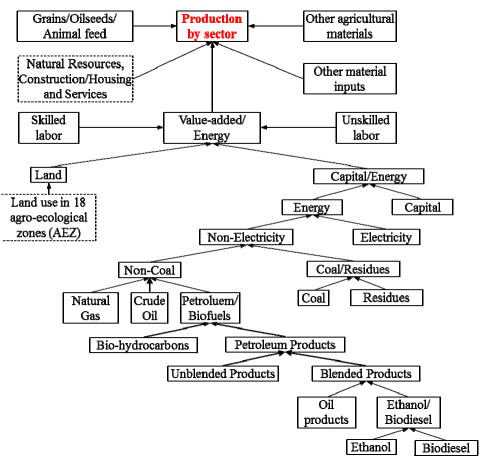
 DownLoad:
DownLoad: 